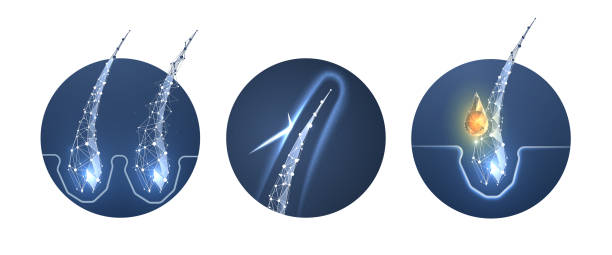The human skin is the biggest organ of the body and in its layers, there are skin organs that help in making hair strands. The follicle is the skin organ that produces hair. The production occurs primarily in three phases which re termed as anagen, catagen and telogen. Anagen is the growth phase, in which the strands grows in the follicle through the nutrients that are provided through blood vessels. The cessation phase catagen, is the phase in which the hair grows longer and thicker. Telogen is the resting phase in which the hair slowly loses its viability and eventually falls off.
Structure of hair follicle
The papilla is a large round structure found at the base of the root. It is shaped like a bulb and is composed of connective tissue and a capillary loop, providing oxygen and nutrients to the follicle. The matrix is found around the papilla and it is a collection of the skin cells that are found with the pigment producing cells called melanocytes. Any kind of malfunction in the melanocytes causes the color to be affected, making it white. Cell division in the matrix produces more cells that form the major structures of the fiber and the inner root sheath. The most interesting thing about matrix is that it is one of the fastest growing cell populations in the human body. This is why some types of chemotherapy treatments harm the matrix, causing the patient to lose hair. The papilla is shaped like a bulb and the matrix surrounds it. This provides access for the capillaries to deliver nutrients to the follicle. The root sheath is another part of the follicle and is composed of an external and internal root sheath. The external root sheath appears hollow while the internal root sheath is composed of three layers. The hair fiber produced through the follicle is built up of keratin, a protein.
Importance of follicular unit in hair transplant surgery
Follicles are the primary part in hair transplant procedures since it is the sack that holds the whole hair producing mechanism. In the various hair restoration methods such as strip harvest, follicular unit extraction (FUE) and follicular unit transplantation (FUT), naturally-occurring groupings of one to four hair, called follicular units, are extracted from the patient and then surgically implanted in the balding area of the patient’s scalp, known as the recipient area. These follicles are extracted from the donor site, usually from the scalp. When these follicles are transplanted to the bald area, they continue to grow in the normal cycle hence providing the patient with a permanent solution to hair loss. Hair transplantation was done in the 1950s for conditions that caused growth disorder such as accidental scars and burns. In the 1990s, the procedure became a cosmetic procedure and people turned to it for hair restoration to treat baldness.
Ask from doctor | Write us or WhatsApp | +92-333-430-9999


